How Sensitive Is Thermal Image-Based Orchard Water Status Estimation to Canopy Extraction Quality?
Abstract
1. Introduction
1.1. Crop Water Status Estimation for Precision Irrigation Management
1.2. Approaches of Thermal Image-Based Canopy Extraction
2. Materials and Methods
2.1. Research Area
2.2. Image Acquisition
2.3. Canopy Extraction Methods
- (1)
- 2-pixel erosion (2PE):
- (2)
- Edge detection (ED) based on [21]:
- Image sharpening with high pass filter (spatial).
- Determination of edges (statistical).
- Morphological expansion of three pixels (spatial).
- Thresholding to extract only canopy pixels (statistical).
- (3)
- Vegetation segmentation (VS) based on [29] written in the Matlab R2020a (Mathworks Inc., Matick, MA, USA):
- (4)
- RGB-based binary masking (RGB-BM):
- Resampling of the RGB to 7.3737 cm.
- Georeferencing between the RGB and thermal layers.
- The excess green index (ExG) (2G-R-B) is calculated per pixel and effectively differentiates between plant and soil pixels [31].
- Binary thresholding of the ExG layer to separate canopy from non-canopy pixels [30] (statistical).
- Thermal image masking using the ExG layer (post-binary thresholding) [24] to retrieve the temperature values of each pixel (spatial).
2.4. Canopy Extraction Quality Evaluation
2.4.1. Canopy Area Consistency
2.4.2. Accuracy Assessment
2.5. Canopy Temperature Calculation
2.6. Orchard Water Status Estimation
2.6.1. Establishment of the Relationship between SWP and CWSI
2.6.2. Estimated Stem Water Potential
3. Results
3.1. Evaluation of Canopy Extraction Quality
3.1.1. Canopy Area Consistency
3.1.2. Accuracy Assessment
3.2. Canopy Temperature Calculation
3.3. Orchard Water Status Estimation
3.3.1. SWP-CWSI Model Comparison
3.3.2. Estimated Stem Water Potential
4. Discussion
5. Conclusions
Author Contributions
Funding
Data Availability Statement
Acknowledgments
Conflicts of Interest
Abbreviations
| CWSI | crop water stress index |
| CWSI_T33% | crop water stress index calculated with the average temperature of the coolest 33% of canopy pixels |
| CWSI_T100% | crop water stress index calculated with the average temperature of 100% of canopy pixels |
| ED | edge detection |
| ExG | excess green index |
| MC | management cell |
| RGB-BM | red –green–blue binary masking |
| SWP | stem water potential (MPa) |
| SWPe_T33% | estimated stem water potential using the average temperature of the coolest 33% of canopy pixels (MPa) |
| SWPe_T100% | estimated stem water potential using the average temperature of 100% of canopy pixels (MPa) |
| T33% | average temperature of the coolest 33% of canopy pixels |
| T100% | average temperature of 100% of canopy pixels |
| VS | vegetation segmentation |
| 2PE | 2-pixel erosion |
References
- Gonzalez-Dugo, V.; Zarco-Tejada, P.J. Assessing the Impact of Measurement Errors in the Calculation of CWSI for Characterizing the Water Status of Several Crop Species. Irrig. Sci. 2022, 1–13. [Google Scholar] [CrossRef]
- Zhou, Z.; Majeed, Y.; Diverres Naranjo, G.; Gambacorta, E. Assessment for Crop Water Stress with Infrared Thermal Imagery in Precision Agriculture: A Review and Future Prospects for Deep Learning Applications. Comput. Electron. Agric. 2021, 182, 106019. [Google Scholar] [CrossRef]
- Jones, H.G. Use of Infrared Thermometry for Estimation of Stomatal Conductance as a Possible Aid to Irrigation Scheduling. Agric. For. Meteorol. 1999, 95, 139–149. [Google Scholar] [CrossRef]
- Idso, S.B.; Jackson, R.D.; Pinter, P.J.; Reginato, R.J.; Hatfield, J.L. Normalizing the Stress-Degree-Day Parameter for Environmental Variability. Agric. Meteorol. 1981, 24, 45–55. [Google Scholar] [CrossRef]
- Jackson, R.D.; Idso, S.B.; Reginato, R.J.; Pinter, P.J. Canopy Temperature as a Crop Water Stress Indicator. Water Resour. Res. 1981, 17(4), 1133–1138. [Google Scholar] [CrossRef]
- Meron, M.; Tsipris, J.; Orlov, V.; Alchanatis, V.; Cohen, Y. Crop Water Stress Mapping for Site-Specific Irrigation by Thermal Imagery and Artificial Reference Surfaces. Precis. Agric. 2010, 11, 148–162. [Google Scholar] [CrossRef]
- Gonzalez-Dugo, V.; Zarco-Tejada, P.; Nicolás, E.; Nortes, P.A.; Alarcón, J.J.; Intrigliolo, D.S.; Fereres, E. Using High Resolution UAV Thermal Imagery to Assess the Variability in the Water Status of Five Fruit Tree Species within a Commercial Orchard. Precis. Agric. 2013, 14, 660–678. [Google Scholar] [CrossRef]
- Cohen, Y.; Alchanatis, V.; Saranga, Y.; Rosenberg, O.; Sela, E. Mapping Water Status Based on Aerial Thermal Imagery: Comparison of Methodologies for Upscaling from a Single Leaf to Commercial Fields. Precis. Agric. 2017, 18, 801–822. [Google Scholar] [CrossRef]
- Rud, R.; Cohen, Y.; Alchanatis, V.; Levi, A.; Brikman, R.; Shenderey, C.; Heuer, B.; Markovitch, T.; Dar, Z.; Rosen, C.; et al. Crop Water Stress Index Derived from Multi-Year Ground and Aerial Thermal Images as an Indicator of Potato Water Status. Precis. Agric. 2014, 15, 273–289. [Google Scholar] [CrossRef]
- Gonzalez-Dugo, V.; Goldhamer, D.; Zarco-Tejada, P.J.; Fereres, E. Improving the Precision of Irrigation in a Pistachio Farm Using an Unmanned Airborne Thermal System. Irrig. Sci. 2015, 33, 43–52. [Google Scholar] [CrossRef]
- Rud, R.; Cohen, Y.; Alchanatis, V.; Beiersdorf, I.; Klose, R.; Presnov, E.; Levi, A.; Brikman, R.; Agam, N.; Dag, A.; et al. Characterization of Salinity-Induced Efects in Olive Trees Based on Thermal Imagery. In Proceedings of the 10th European Conference on Precision Agriculture; Stafford, J.V., Ed.; Wageningen Academic Publishers: Rishon-LeZion, Israel, 2015; pp. 511–518. [Google Scholar]
- Egea, G.; Padilla-Díaz, C.M.; Martinez-Guanter, J.; Fernández, J.E.; Pérez-Ruiz, M. Assessing a Crop Water Stress Index Derived from Aerial Thermal Imaging and Infrared Thermometry in Super-High Density Olive Orchards. Agric. Water Manag. 2017, 187, 210–221. [Google Scholar] [CrossRef]
- Agam, N.; Cohen, Y.; Berni, J.A.J.; Alchanatis, V.; Kool, D.; Dag, A.; Yermiyahu, U.; Ben-Gal, A. An Insight to the Performance of Crop Water Stress Index for Olive Trees. Agric. Water Manag. 2013, 118, 79–86. [Google Scholar] [CrossRef]
- Cohen, Y.; Alchanatis, V.; Prigojin, A.; Levi, A.; Soroker, V.; Cohen, Y. Use of Aerial Thermal Imaging to Estimate Water Status of Palm Trees. Precis. Agric. 2012, 13, 123–140. [Google Scholar] [CrossRef]
- Baluja, J.; Diago, M.P.; Balda, P.; Zorer, R.; Meggio, F.; Morales, F.; Tardaguila, J. Assessment of Vineyard Water Status Variability by Thermal and Multispectral Imagery Using an Unmanned Aerial Vehicle (UAV). Irrig. Sci. 2012, 30, 511–522. [Google Scholar] [CrossRef]
- Camino, C.; Zarco-Tejada, P.J.; Gonzalez-Dugo, V. Effects of Heterogeneity within Tree Crowns on Airborne-Quantified SIF and the CWSI as Indicators of Water Stress in the Context of Precision Agriculture. Remote Sens. 2018, 10, 604. [Google Scholar] [CrossRef]
- Nixon, M.S.; Aguado, A.S. Region-Based Analysis. In Feature Extraction and Image Processing for Computer Vision, 4th ed.; Nixon, M.S., Aguado, A.S., Eds.; Academic Press: Cambridge, MA, USA, 2020; pp. 399–432. [Google Scholar]
- Zhou, Y.; Wang, L.; Jiang, K.; Xue, L.; An, F.; Chen, B.; Yun, T. Individual Tree Crown Segmentation Based on Aerial Image Using Superpixel and Topological Features. J. Appl. Remote Sens. 2020, 14, 1. [Google Scholar] [CrossRef]
- Maheswari, P.; Raja, P.; Apolo-Apolo, O.E.; Pérez-Ruiz, M. Intelligent Fruit Yield Estimation for Orchards Using Deep Learning Based Semantic Segmentation Techniques—A Review. Front. Plant Sci. 2021, 12, 684328. [Google Scholar] [CrossRef]
- Katz, L.; Ben-Gal, A.; Litaor, M.I.; Naor, A.; Peres, M.; Bahat, I.; Netzer, Y.; Peeters, A.; Alchanatis, V.; Cohen, Y. Spatiotemporal Normalized Ratio Methodology to Evaluate the Impact of Field-Scale Variable Rate Application. Precis. Agric. 2022, 23, 1125–1152. [Google Scholar] [CrossRef]
- Park, S.; Ryu, D.; Fuentes, S.; Chung, H.; Hernández-Montes, E.; O’Connell, M. Adaptive Estimation of Crop Water Stress in Nectarine and Peach Orchards Using High-Resolution Imagery from an Unmanned Aerial Vehicle (UAV). Remote Sens. 2017, 9, 828. [Google Scholar] [CrossRef]
- Bian, J.; Zhang, Z.; Chen, J.; Chen, H.; Cui, C.; Li, X.; Chen, S.; Fu, Q. Simplified Evaluation of Cotton Water Stress Using High Resolution Unmanned Aerial Vehicle Thermal Imagery. Remote Sens. 2019, 11, 267. [Google Scholar] [CrossRef]
- Cohen, Y.; Alchanatis, V.; Meron, M.; Saranga, Y.; Tsipris, J. Estimation of Leaf Water Potential by Thermal Imagery and Spatial Analysis. J. Exp. Bot. 2005, 56, 1843–1852. [Google Scholar] [CrossRef] [PubMed]
- Osroosh, Y.; Khot, L.R.; Peters, R.T. Economical Thermal-RGB Imaging System for Monitoring Agricultural Crops. Comput. Electron. Agric. 2018, 147, 34–43. [Google Scholar] [CrossRef]
- Zhou, Z.; Diverres, G.; Kang, C.; Thapa, S.; Karkee, M.; Zhang, Q.; Keller, M. Ground-Based Thermal Imaging for Assessing Crop Water Status in Grapevines over a Growing Season. Agronomy 2022, 12, 322. [Google Scholar] [CrossRef]
- Bahat, I.; Netzer, Y.; Grünzweig, J.M.; Alchanatis, V.; Peeters, A.; Goldshtein, E.; Ohana-Levi, N.; Ben-Gal, A.; Cohen, Y. In-Season Interactions between Vine Vigor, Water Status and Wine Quality in Terrain-Based Management-Zones in a ‘Cabernet Sauvignon’ Vineyard. Remote Sens. 2021, 13, 1636. [Google Scholar] [CrossRef]
- Katz, L.; Ben-Gal, A.; Litaor, M.I.; Naor, A.; Peres, M.; Peeters, A.; Alchanatis, V.; Cohen, Y. A Spatiotemporal Decision Support Protocol Based on Thermal Imagery for Variable Rate Drip Irrigation of a Peach Orchard. Irrig. Sci. 2022, 42, 1118–1126. [Google Scholar] [CrossRef]
- Dag, A.; Alchanatis, V.; Zipori, I.; Sprinstin, M.; Cohen, A.; Maravi, T.; Naor, A. Automated Detection of Malfunctions in Drip-Irrigation Systems Using Thermal Remote Sensing in Vineyards and Olive Orchards. In Precision Agriculture ’15; Wageningen Academic Publishers: Rishon-LeZion, Israel, 2015; pp. 12–23. [Google Scholar]
- Kalo, N.; Edan, Y.; Alchanatis, V. Detection of Irrigation Malfunctions Based on Thermal Imaging. In Proceedings of the Precision Agriculture’21; Wageningen Academic Publishers: Noordwijk, The Netherlands, 2021; pp. 2217–2224. [Google Scholar]
- Otsu, N. A Threshold Selection Method from Gray-Level Histograms. IEEE Trans. Syst. Man. Cybern. 1979, 9, 62–66. [Google Scholar] [CrossRef]
- Hamuda, E.; Glavin, M.; Jones, E. A Survey of Image Processing Techniques for Plant Extraction and Segmentation in the Field. Comput. Electron. Agric. 2016, 125, 184–199. [Google Scholar] [CrossRef]
- Steduto, P.; Hsiao, T.C.; Fereres, E.; Raes, D. Crop Yield Response to Water; Food and Agriculture Organization of the United Nations: Rome, Italy, 2012; Volume 1028. [Google Scholar]
- Zhong, L.; Hu, L.; Zhou, H. Deep Learning Based Multi-Temporal Crop Classification. Remote Sens. Environ. 2019, 221, 430–443. [Google Scholar] [CrossRef]
- Hijmans, R.J. Raster: Geographic Data Analysis and Modeling. 2019. Available online: https://rspatial.org/raster (accessed on 10 January 2022).
- Bivand, R.; Keitt, T.; Rowlingson, B. Rgdal: Bindings for the “Geospatial” Data Abstraction Library. 2019. Available online: http://rgdal.r-forge.r-project.org/ (accessed on 10 January 2022).
- Wickham, H. Reshaping Data with the {reshape} Package. J. Stat. Softw. 2007, 21, 1–20. [Google Scholar] [CrossRef]
- R Core Team R: A Language and Environment for Statistical Computing; R Core Team: Vienna, Austria, 2019.
- Wickham, H. Ggplot2: Elegant Graphics for Data Analysis; Springer-Verlag: New York, NY, USA, 2016; ISBN 978-3-319-24277-4. [Google Scholar]
- Shimshowitz, E. The Effect of Irrigation and Crop Load on Crop Yield Anf Fruit Size Distribution in Nectarine Cv. Arctic Mist. Master’s Thesis, Tel Hai Academic College, Upper Galilee, Qiryat Shemona, Israel, 2018. [Google Scholar]
- Meron, M.; Sprintsin, M.; Tsipris, J.; Alchanatis, V.; Cohen, Y. Foliage Temperature Extraction from Thermal Imagery for Crop Water Stress Determination. Precis. Agric. 2013, 14, 467–477. [Google Scholar] [CrossRef]
- Lee, M.K.; Golzarian, M.R.; Kim, I. A New Color Index for Vegetation Segmentation and Classification. Precis. Agric. 2021, 22, 179–204. [Google Scholar] [CrossRef]
- Gonzalez-Dugo, V.; Zarco-Tejada, P.; Berni, J.A.J.; Suárez, L.; Goldhamer, D.; Fereres, E. Almond Tree Canopy Temperature Reveals Intra-Crown Variability That Is Water Stress-Dependent. Agric. For. Meteorol. 2012, 154–155, 156–165. [Google Scholar] [CrossRef]
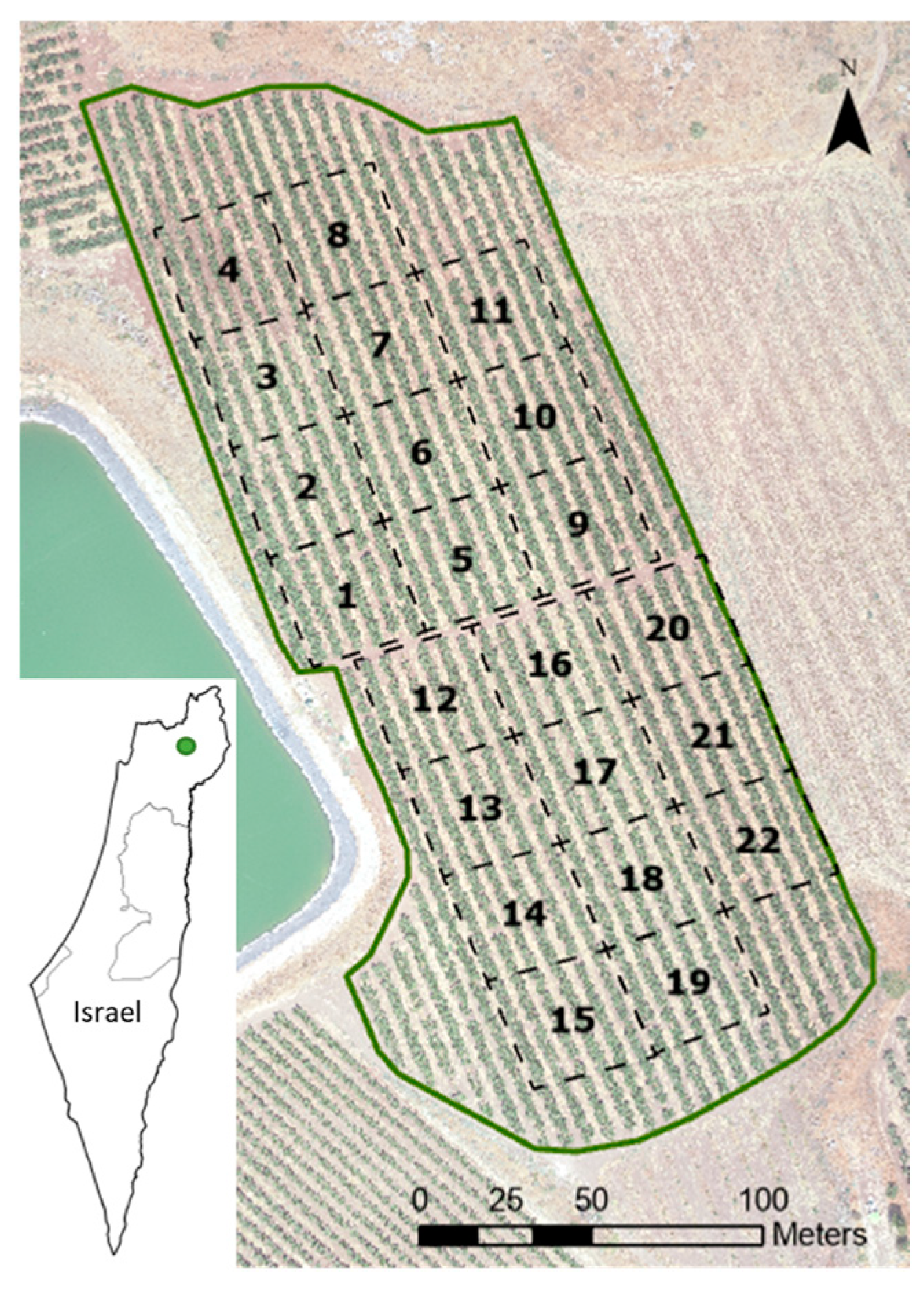
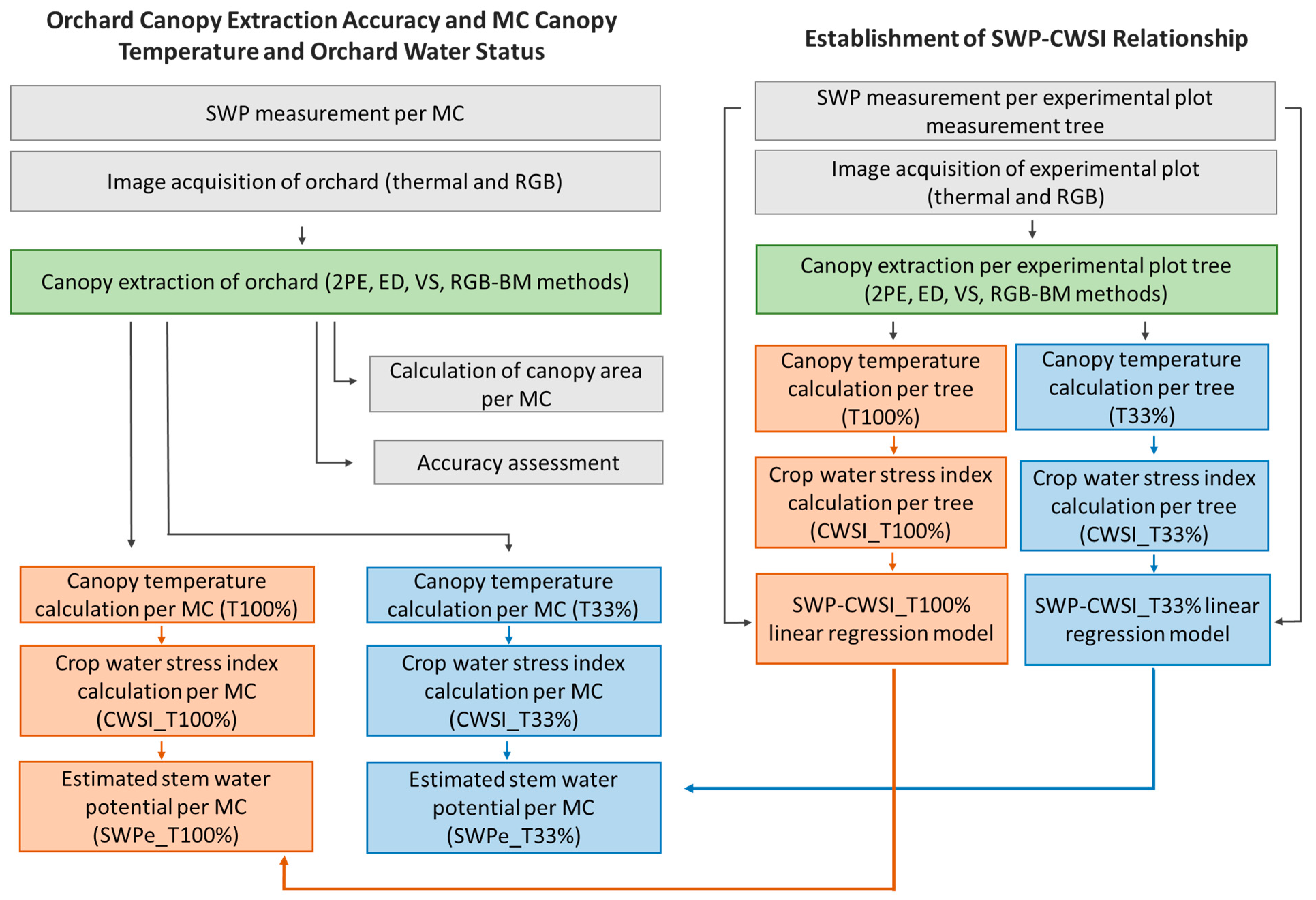
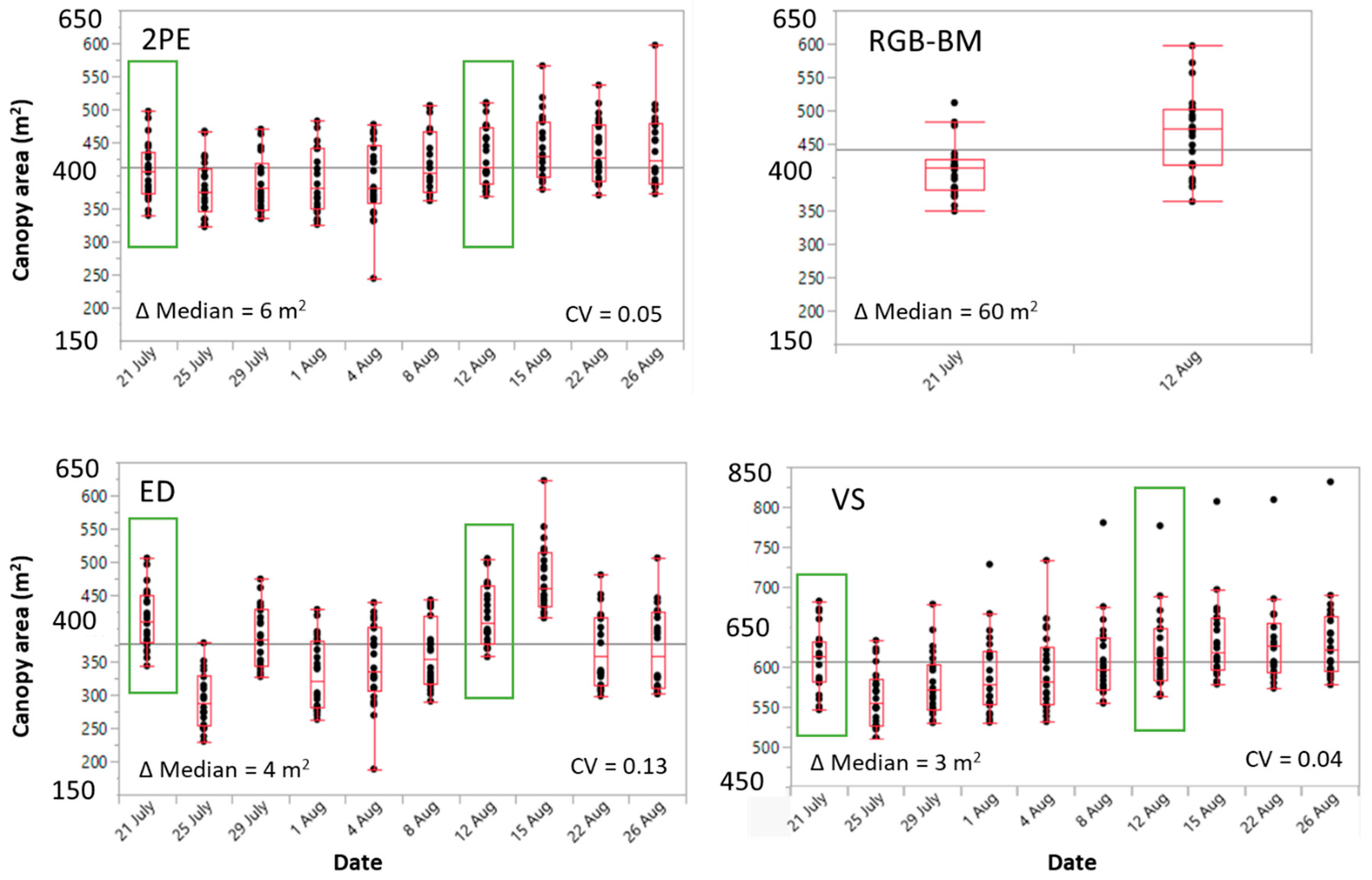
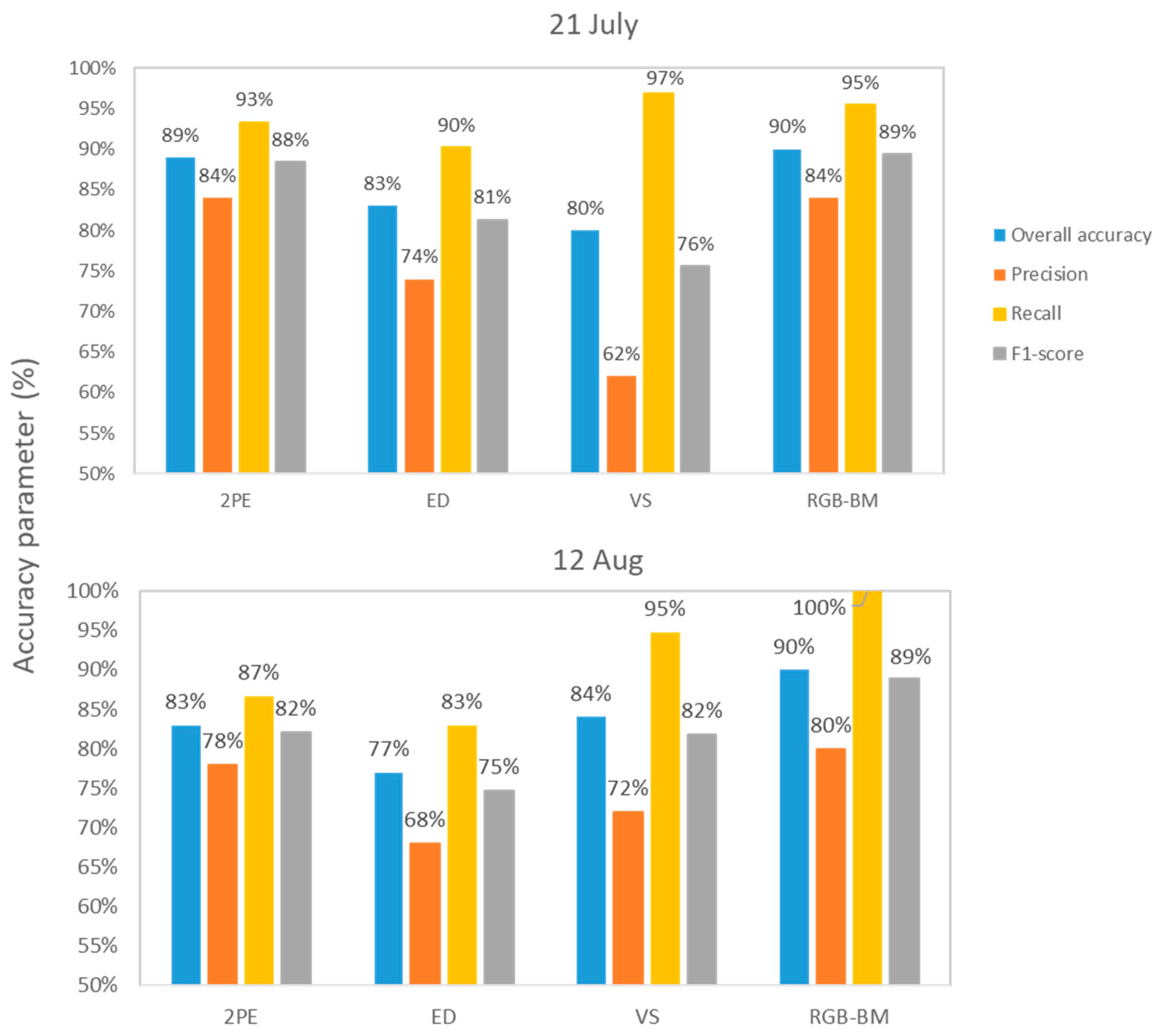
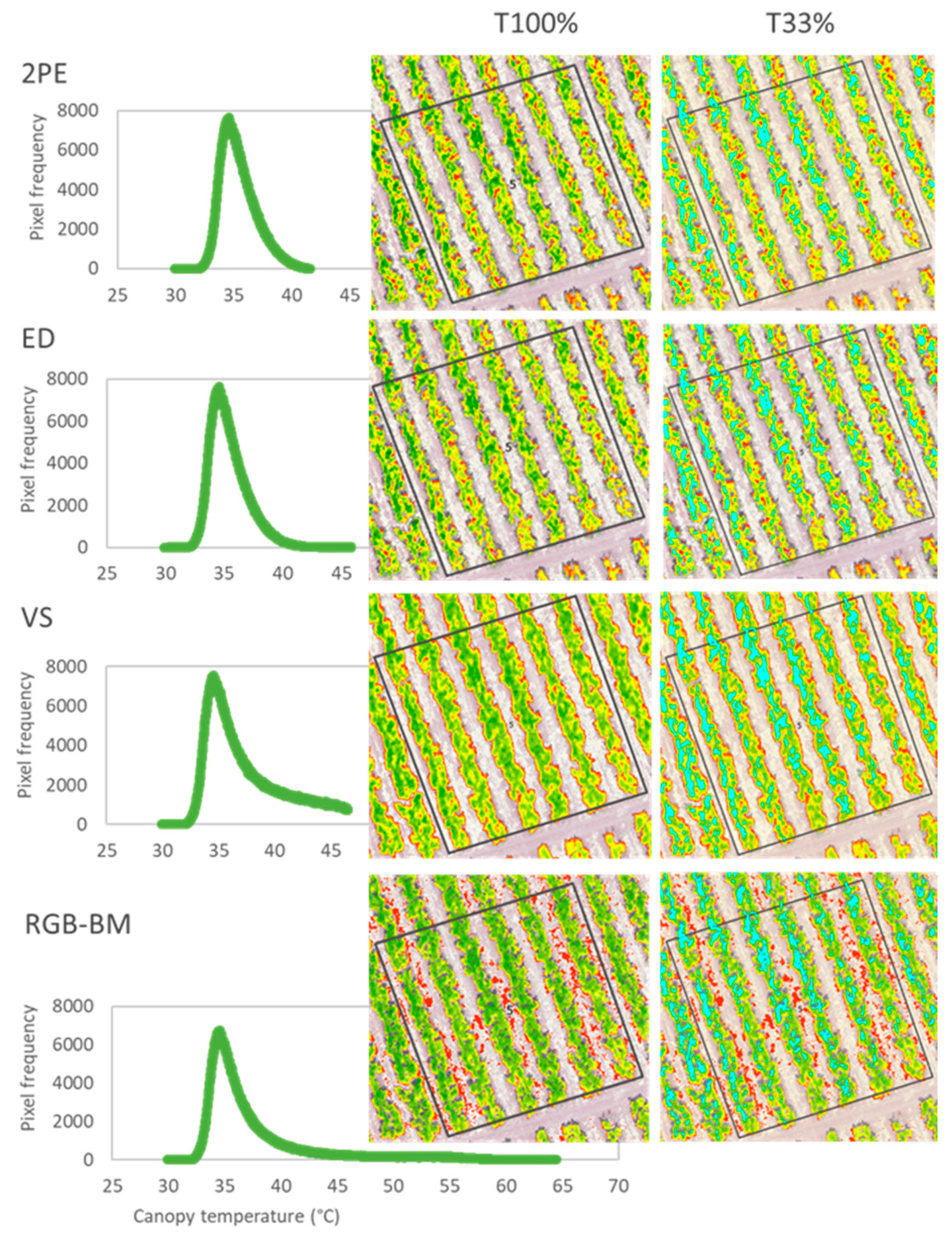


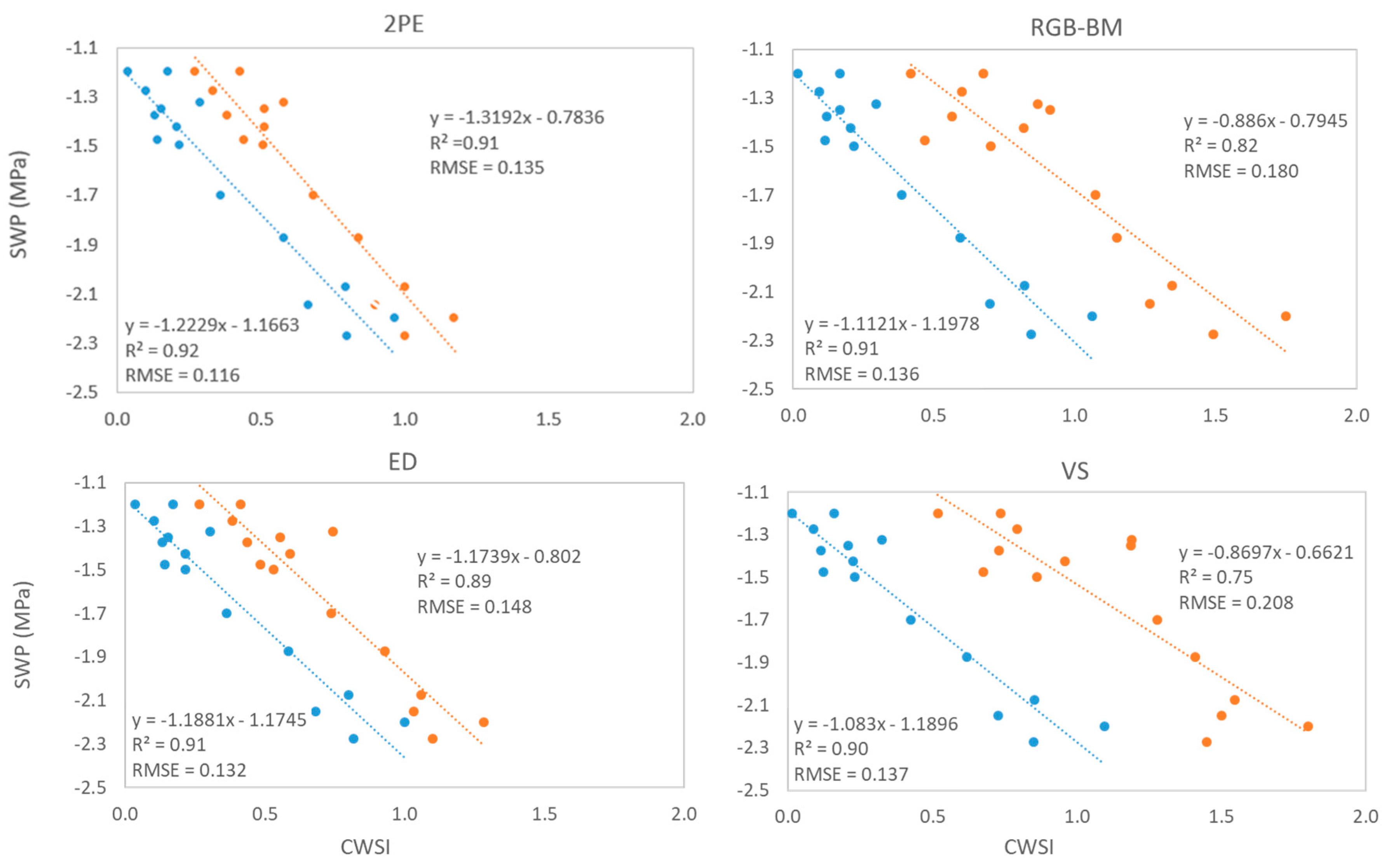


Disclaimer/Publisher’s Note: The statements, opinions and data contained in all publications are solely those of the individual author(s) and contributor(s) and not of MDPI and/or the editor(s). MDPI and/or the editor(s) disclaim responsibility for any injury to people or property resulting from any ideas, methods, instructions or products referred to in the content. |
© 2023 by the authors. Licensee MDPI, Basel, Switzerland. This article is an open access article distributed under the terms and conditions of the Creative Commons Attribution (CC BY) license (https://creativecommons.org/licenses/by/4.0/).
Share and Cite
Katz, L.; Ben-Gal, A.; Litaor, M.I.; Naor, A.; Peeters, A.; Goldshtein, E.; Lidor, G.; Keisar, O.; Marzuk, S.; Alchanatis, V.; et al. How Sensitive Is Thermal Image-Based Orchard Water Status Estimation to Canopy Extraction Quality? Remote Sens. 2023, 15, 1448. https://doi.org/10.3390/rs15051448
Katz L, Ben-Gal A, Litaor MI, Naor A, Peeters A, Goldshtein E, Lidor G, Keisar O, Marzuk S, Alchanatis V, et al. How Sensitive Is Thermal Image-Based Orchard Water Status Estimation to Canopy Extraction Quality? Remote Sensing. 2023; 15(5):1448. https://doi.org/10.3390/rs15051448
Chicago/Turabian StyleKatz, Livia, Alon Ben-Gal, M. Iggy Litaor, Amos Naor, Aviva Peeters, Eitan Goldshtein, Guy Lidor, Ohaliav Keisar, Stav Marzuk, Victor Alchanatis, and et al. 2023. "How Sensitive Is Thermal Image-Based Orchard Water Status Estimation to Canopy Extraction Quality?" Remote Sensing 15, no. 5: 1448. https://doi.org/10.3390/rs15051448
APA StyleKatz, L., Ben-Gal, A., Litaor, M. I., Naor, A., Peeters, A., Goldshtein, E., Lidor, G., Keisar, O., Marzuk, S., Alchanatis, V., & Cohen, Y. (2023). How Sensitive Is Thermal Image-Based Orchard Water Status Estimation to Canopy Extraction Quality? Remote Sensing, 15(5), 1448. https://doi.org/10.3390/rs15051448








